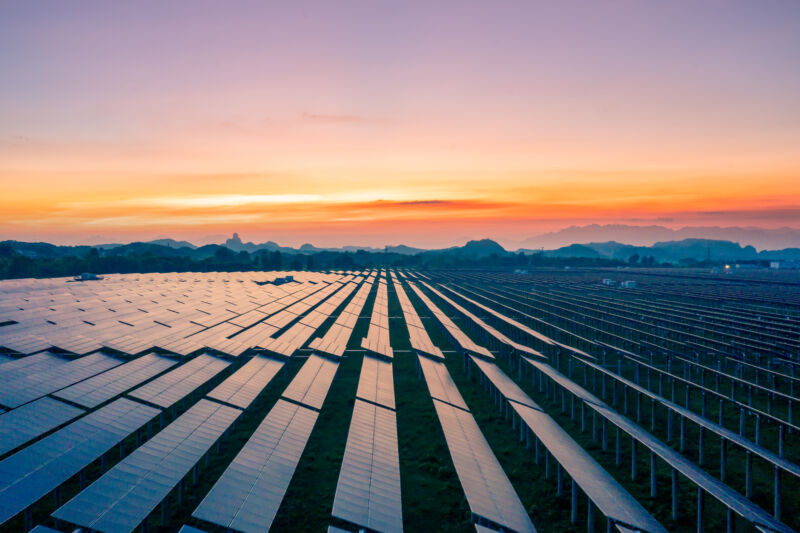Once solar panels are operative, they produce electricity without carbon emissions. But making and installing them involves some emissions. Most of the worries about solar panel production have focused on the elements that go into the panels themselves, like gallium, cadmium, germanium, indium, selenium, and tellurium. But according to new research, the massive amount of aluminum needed to house the solar rigs of the future could create further problems.
“I hadn’t realized just how much aluminum was required for the frames and the modules, mountings, and inverters,” Alison Lennon, a researcher at UNSW Sydney’s School of Photovoltaic and Renewable Energy Engineering, told Ars. She added that aluminum is often used because it is lightweight and corrosion-resistant.
In 2020, the World Bank released an oft-cited analysis called "Minerals for Climate Action: The Mineral Intensity of the Clean Energy Transition.” In this report, the authors identified aluminum as one of the minerals that would need to have its production scale by a large amount for the world to meet its climate goals. “PV was a large contributor,” Lennon said. “[This] made me think about the problem a bit more.”
However, Lennon said that the World Bank report assumed an early International Energy Agency clean energy roadmap, which predicted that only 4 TW of photovoltaics would need to be installed by 2050. This is a small sum compared to what many updated roadmaps are now predicting.
In Lennon’s paper, she and her team used the target of 60 TW, set by the most recent International Technology Roadmap for Photovoltaics (ITRPV). This would mean that the world would need to produce 4.5 TW of additional capacity each year until 2050 to reach net-zero emissions and limit global warming to under 2°C. For context, by the end of 2020, just over 700 GW were installed.
Gonna carry that weight
The ITRPV report goes into granular detail about the state of the solar energy field, from the size of the modules and their efficiencies to which ones have aluminum frames. Lennon’s team extrapolated this data from 2030 to 2050 and used data from the industry to measure factors such as how much aluminum is in the frames and how much recycled aluminum can be used in frames and mountings. The team also looked at how the industry would change over time, examining the prospects of increasing the efficiency of construction.
From this data analysis, the team was able to predict the amount of aluminum the world would need by 2050.
The total came to 486 million metric tons to be used for frames, mountings, and inverter casings. To put this number into context, the world bank had calculated around 100 million metric tons. “Our estimate is a lot larger than the World Bank’s estimates,” Lennon said. “The amount of aluminum we’re going to have to produce is going to have to increase an awful lot from what we have now.”
The problem is not that there’s not enough aluminum in the world—as it is both quite common and fairly easy to extract. Rather, the required extraction and production could lead to a lot of greenhouse gas emissions. Producing one tonne of aluminum from bauxite—a common source of the element—results in between 14 and 16 metric tons of CO2 or equivalent (the paper assumes the process is done in China), Lennon said. “That’s really high,” she said, adding that the smelting process can be quite energy-intensive. “If your electricity is sourced by coal-fired power or fossil fuels in general, the emissions intensity [can be] huge.”
Lennon noted that decarbonizing a country’s electricity system could cut down on the emissions. The study concludes that it is possible for the world to get enough aluminum for the photovoltaics but that it will require some changes to how it's produced. Another solution is to use recycled aluminum. Aluminum is “infinitely recyclable,” she said. “[W]e need to think carefully about how the aluminum is produced."
“I think it’s a good story for the PV industry, provided we can get the aluminum industry working along with us, helping to reduce those emissions," Lennon said.
Nature, 2022. DOI: 10.1038/s41893-021-00838-9 (About DOIs)



3175x175(CURRENT).thumb.jpg.b05acc060982b36f5891ba728e6d953c.jpg)

Recommended Comments
There are no comments to display.
Join the conversation
You can post now and register later. If you have an account, sign in now to post with your account.
Note: Your post will require moderator approval before it will be visible.